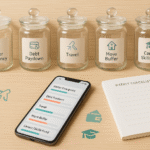If you’ve been staring down a pile of balances and wondering where to start, the debt snowball method offers a clear, motivating path forward. In simple terms, you list your debts from the smallest balance to the largest, pay minimums on all of them, and throw every extra dollar at the smallest first. Each payoff creates a quick win that fuels the next—like a snowball gathering size and speed as it rolls. This article walks you through the top five benefits of using the debt snowball method, plus step-by-step guidance, a quick-start checklist, troubleshooting, metrics to track, and a simple 4-week plan to get momentum immediately.
Disclaimer: The information below is educational and not individualized financial advice. Your situation may require guidance from a qualified financial professional.
Key takeaways
- Momentum matters: Small early wins build motivation, making it easier to stick with a payoff plan over time.
- Simplicity wins in the real world: A clear, rule-based order of attack reduces decision fatigue and improves follow-through.
- Cash flow accelerates: As you close accounts, minimum payments roll into bigger principal payments, speeding up the journey.
- Habits and resilience grow: The method pairs naturally with budgeting, autopay, and progress tracking, which lowers stress.
- Flexible and forgiving: You can adapt your snowball when life happens and still keep moving toward debt freedom.
1) Momentum From Small Wins: A Psychology-Powered Path You’ll Actually Follow
What it is and why it helps
The defining feature of the debt snowball method is prioritizing your smallest balance first, regardless of interest rate. The early payoffs deliver fast, visible progress—an immediate sense of accomplishment that’s hard to get from long, complex payoff schedules. Behavioral research shows that progress cues and small wins boost motivation, reduce the urge to quit, and help people persist on long tasks. In debt repayment, this translates into more consistent payments, less procrastination, and better adherence to a plan you’ve already chosen.
Core benefits:
- Early wins that feel tangible and motivating.
- Simpler decisions (no recalculating interest tradeoffs each month).
- Higher follow-through thanks to visible progress and feedback loops.
Requirements and low-cost alternatives
- You need: A list of every debt (lender, balance, APR, minimum), a monthly budget, and a way to track payments.
- Nice-to-have: A spreadsheet or budgeting app; payment reminders; calendar blocks for “money hour.”
- Low-cost alternatives: Paper and pen; a printable debt tracker; bank’s free alerts.
Step-by-step implementation
- List debts by balance (smallest to largest). Include minimum payments and due dates.
- Pay minimums on all debts, then direct every extra dollar to the smallest balance.
- Celebrate the payoff (mark it “closed,” keep a visible checklist).
- Roll the freed minimum into the next smallest balance; repeat.
- Automate minimums where possible; schedule your snowball transfer the same day you’re paid.
- Track progress weekly to keep the motivation loop alive.
Beginner modifications and progressions
- Mod: If you’re nervous, start with a “warm-up snowflake”—$10–$25 extra this week just to feel the process.
- Progression: After two months, add a debt-payoff sprint week: sell one item, skip two takeout meals, and add those dollars to your snowball.
- Advanced: Pair the snowball with biweekly payments or a second monthly sweep on your paydays.
Frequency, duration, and metrics
- Cadence: Review debts weekly for 10–15 minutes; make snowball payments each payday.
- Metrics: Debts closed; months to next payoff; total interest paid this month; total principal reduced.
Safety, caveats, and common mistakes
- Caveat: This approach may not minimize interest costs compared to other strategies (e.g., attacking the highest APR first).
- Mistake to avoid: Stopping contributions to an emergency buffer entirely; even a small cushion lowers the risk of new debt.
- Safety tip: Keep minimums current on every account to protect your payment history.
Mini-plan example (2–3 steps)
- This week: List debts and set $50 for the smallest balance.
- This paycheck: Pay minimums + $50 extra to the smallest.
- Next paycheck: Pay minimums + $50 plus any freed minimum from the paid-off account.
2) Simplicity That Reduces Decision Fatigue and Increases Follow-Through
What it is and why it helps
Complex payoff schedules can be mathematically optimal but hard to maintain. The debt snowball method gives you a single, easy rule—smallest balance first—so you always know what to do next. Less mental juggling means fewer excuses, faster action, and less “analysis paralysis.”
Core benefits:
- Clarity: A fixed, transparent order.
- Speed to action: You can start today with your first extra payment.
- Lower cognitive load: No need to compute marginal interest tradeoffs monthly.
Requirements and low-cost alternatives
- You need: One prioritized list and due-date reminders.
- Nice-to-have: A calendar block (“Money Monday,” 20 minutes) and a dashboard showing your next target.
- Low-cost alternative: Use a sticky note on your laptop or phone lock screen: “Next target: Card B, $740.”
Step-by-step implementation
- Rank debts by balance.
- Circle the current target and write the exact extra dollar amount you’ll send on payday.
- Pre-schedule that transfer after your paycheck clears.
- Repeat until the next target becomes the focus.
Beginner modifications and progressions
- Mod: Can’t pre-schedule? Put a calendar alert on payday with the payment link in the reminder.
- Progression: Add a weekly 5-minute budget scrub to hunt for $5–$15 “snowflakes” (unused subscriptions, small refunds).
Frequency, duration, and metrics
- Cadence: Weekly 5–20 minutes; payments aligned to paydays.
- Metrics: Days since last extra payment; number of “no-decision” actions (automations) you’ve set up.
Safety, caveats, and common mistakes
- Caveat: Simple should not mean sloppy—double-check that all minimums are covered before sending extra.
- Mistake to avoid: Ignoring high-interest payday or title loans that might require immediate negotiation even if they’re not the smallest.
Mini-plan example
- Today: Create the list, highlight the smallest balance.
- Tonight: Set a payday reminder with the target amount and payment link.
3) Faster Cash-Flow Relief as Minimums Roll Up Into a Bigger “Snowball”
What it is and why it helps
Every time you close a debt, its minimum payment disappears, freeing cash that immediately rolls into larger principal payments on the next target. That compounding payment power is the “snowball” effect: your monthly payoff amount grows over time without increasing your budget, accelerating each subsequent payoff and delivering psychological as well as financial relief.
Core benefits:
- Bigger principal payments month after month without raising your out-of-pocket total.
- Noticeably lower payment pressure as accounts close.
- Earlier debt closures that reduce the chance of missed payments and late fees on those accounts.
Requirements and low-cost alternatives
- You need: Ability to track minimum payments and update your total snowball amount as each account is closed.
- Nice-to-have: A simple spreadsheet that updates your “rolling snowball” automatically.
- Low-cost alternative: Write your current snowball amount on an index card and replace it every time you close a debt.
Step-by-step implementation
- Calculate your initial snowball amount: Sum of all minimums + any extra you can send.
- After a payoff, immediately add that old minimum to your snowball amount for the next debt.
- Use windfalls (tax refunds, bonuses, side-gig cash) to create “snowblasts” that retire a target faster.
- Re-project your payoff date after each win to see acceleration.
Beginner modifications and progressions
- Mod: Start with just your minimums rolling over; add extra dollars later when your budget stabilizes.
- Progression: Move to biweekly snowball transfers if you’re paid twice per month, reducing average daily balances sooner.
Frequency, duration, and metrics
- Cadence: Update your rolling snowball immediately after each payoff. Review monthly for accuracy.
- Metrics: Current snowball amount; time to next payoff; cumulative freed minimums.
Safety, caveats, and common mistakes
- Caveat: If a high-APR debt sits far down your list, consider a temporary hybrid (see FAQ) to reduce costly interest while keeping momentum.
- Mistake to avoid: Treating freed minimums as spending money instead of rolling them into the next target.
Mini-plan example
- This paycheck: Pay minimums + $75 extra to the smallest.
- After payoff: Increase the next payment by the old minimum ($35) + $75 extra.
- Next month: Add any windfall (e.g., $120) as a one-time “snowblast.”
4) Habit-Building, Lower Stress, and Better Budget Alignment
What it is and why it helps
Debt payoff is a long game. The debt snowball method supports repeatable habits—same cadence, same target type, same tracking—so it’s easier to stay on autopilot. The clarity of goals and frequent feedback reduce mental clutter. Over time, people tend to experience less anxiety, better budgeting discipline, and fewer “I’ll deal with it later” moments because the next step is always obvious.
Core benefits:
- Predictability: The plan doesn’t change month to month.
- Confidence: Closed accounts become visible trophies of progress.
- Budget alignment: It pairs naturally with zero-based budgets, cash stuffing, or simple “50/30/20” styles.
Requirements and low-cost alternatives
- You need: A basic budget and an emergency buffer (even a few hundred dollars helps).
- Nice-to-have: Envelope or category systems for spending; automatic bill-pay.
- Low-cost alternatives: Free budget templates; bank alerts; a monthly “money date” with yourself or a partner.
Step-by-step implementation
- Choose a budgeting style that’s easy to maintain (simple beats perfect).
- Create a “debt snowball” budget line so money is earmarked on payday.
- Schedule a weekly money check-in to track balances, celebrate wins, and adjust.
Beginner modifications and progressions
- Mod: Start with a micro-buffer (e.g., $250–$500) so small emergencies don’t derail your plan.
- Progression: Increase your buffer to one month of expenses once your first two debts are gone.
Frequency, duration, and metrics
- Cadence: Weekly 15-minute check-ins; monthly budget refresh.
- Metrics: Number of money check-ins completed; buffer size; missed-payment count (target: zero).
Safety, caveats, and common mistakes
- Caveat: Don’t ignore irregular expenses (car maintenance, annual fees). Instead, save small monthly amounts in sinking funds.
- Mistake to avoid: Using new credit immediately after closing accounts; give yourself a “cool-down” period.
Mini-plan example
- Weekly: 15 minutes to log balances and note next action.
- Monthly: Increase your snowball line by $10–$25 if your budget allows.
- Quarterly: Review progress and reset targets for the next three months.
5) Flexible, Forgiving, and Easy to Adapt When Life Happens
What it is and why it helps
The debt snowball method is structure with built-in flexibility. If income dips, you can maintain minimums and keep your plan intact. If income rises or you receive a windfall, you can “snowblast” a target. You can pause temporarily (for medical bills, job transitions, or moving) without re-engineering a complex, interest-optimized model from scratch.
Core benefits:
- Adaptable to variable income or seasonal work.
- Compatible with negotiation (e.g., payment plans or settlements on specific accounts).
- Portable across financial tools—works with paper trackers, budgeting apps, or simple bank transfers.
Requirements and low-cost alternatives
- You need: A clear minimums-first rule and a ranked list you can edit if a balance changes.
- Nice-to-have: A “rainy day” mini-fund to avoid new debt when surprises happen.
- Low-cost alternatives: If tools feel overwhelming, use a single sheet titled “Debts Ranked” on the fridge or in your phone notes.
Step-by-step implementation
- Set your default: Keep minimums current; attack the smallest balance.
- If circumstances change: Re-rank the list only when a balance meaningfully changes (e.g., consolidation, settlement).
- If you earn extra: Apply “snowblasts” to your current target and update your payoff projection.
Beginner modifications and progressions
- Mod: If an emergency hits, reduce your extra payment temporarily but don’t stop tracking.
- Progression: When income stabilizes, add a second automatic snowball transfer mid-month.
Frequency, duration, and metrics
- Cadence: Re-rank only when balances change meaningfully; otherwise, review weekly.
- Metrics: Months on plan; number of deviations that required a re-rank (keep this low).
Safety, caveats, and common mistakes
- Caveat: For accounts with fees or penalties (e.g., deferred interest promotions), check terms before deprioritizing.
- Mistake to avoid: Resetting the whole plan for small fluctuations; consistency beats constant tinkering.
Mini-plan example
- This month: Keep minimums; send $100 extra to the smallest debt.
- If a surprise bill hits: Send $25 extra, then catch up next month with $175 extra.
- After a bonus: Add a $300 snowblast to your current target.
Quick-Start Checklist
- List every debt: Lender, balance, APR, minimum, due date.
- Rank by balance: Smallest to largest; highlight your current target.
- Set automations: Minimums on autopay; calendar reminders for snowball transfers.
- Create a micro-buffer: $250–$500 to handle small surprises.
- Name your payment days: E.g., “Snowball Friday” every payday.
- Track progress visually: Checklist on the fridge or a simple dashboard.
- Plan a celebration for each win: Low-cost ritual that reinforces momentum.
Troubleshooting & Common Pitfalls
“I keep losing motivation.”
Reconnect to progress. Print a one-page tracker that shows balances shrinking and accounts closed. Schedule a 10-minute weekly celebration ritual—check the box, total your principal paid, and choose one small reward (a favorite coffee or a night walk).
“A high-interest card is far down my list.”
Use a hybrid: Keep the snowball order, but send an extra micro-payment (even $10–$20 per week) to the high-APR card to limit interest costs while preserving momentum.
“Unexpected bills keep derailing me.”
Start a sinking fund with tiny amounts: $15/month for car maintenance, $10/month for gifts, etc. These small cushions can prevent new debt while you snowball.
“I miss payments because I forget.”
Autopay all minimums. Then, schedule your snowball transfer on payday and set a reminder. If possible, make the transfer the same day you get paid.
“My income is irregular.”
Adopt a percentage-based snowball: Commit a fixed percent of each paycheck (e.g., 10%) to the current target. Add windfalls as “snowblasts.”
“I’m worried about interest costs.”
It’s true that a different order may save more interest. Many people still choose the snowball for adherence and psychological momentum. If you’re comfortable optimizing, try a debt avalanche instead—or keep your snowball and add small extra payments to any high-APR balance along the way.
“My partner isn’t on board.”
Schedule a 20-minute “money date.” Start with the vision: what life looks like debt-free. Show the timeline to the first payoff (often just a few weeks). The short time to a concrete win often wins support.
“I paid off a card—now I want to use it.”
Freeze the card (literally in ice, or with a digital wallet pause) and give yourself a 30-day cooling-off period. Revisit later with a specific purpose and spending rule.
How to Measure Progress (So You Don’t Lose Steam)
Track leading and lagging indicators:
- Leading indicators (drive future success):
- Number of weekly money check-ins completed.
- Number of automated payments set up.
- Dollars added to “snowblasts” from selling items or side gigs.
- Lagging indicators (show results to date):
- Debts closed this quarter.
- Total principal paid this month vs. last month.
- Total interest paid this month vs. last month (aim for downtrend).
- Projected debt-free date (update after each payoff).
Create a one-page dashboard with your current target, the next two targets, and your rolling snowball amount. The fewer clicks between you and your data, the faster you’ll act.
A Simple 4-Week Starter Plan
Week 1 — Set the stage
- List every debt; rank by balance.
- Autopay all minimums.
- Pick a micro-buffer target (e.g., $300) and start with $50.
- Make your first extra payment—even $20—on the smallest balance.
Week 2 — Build your routine
- Schedule a weekly 15-minute money check-in (stick to it).
- Identify two quick budget wins (pause one subscription, swap two takeout meals).
- Add those dollars to your next snowball transfer.
Week 3 — Increase the snowball
- Sell one unused item or pick up one small side gig shift.
- Add 50–100% of that income as a “snowblast” to your current target.
- Recalculate your projected debt-free date to see the acceleration.
Week 4 — Lock in the habit
- Review the month: Debts closed? Principal paid? Interest paid?
- Raise your snowball amount by $10–$25 if feasible.
- Plan a modest celebration tied to your progress, then set next month’s mini-goals.
Repeat this 4-week cycle. Each month, your snowball should grow a bit larger, your confidence a bit stronger, and your path a bit clearer.
FAQs
1) Is the debt snowball method always the best choice?
Not always. If your priority is minimizing total interest, paying the highest APR first (often called an “avalanche”) can be more cost-efficient. Many people still choose the snowball because its early wins make the plan easier to stick with.
2) Which debts should I include in my snowball?
Include consumer debts like credit cards, personal loans, medical bills, and small auto or student loans. Exclude mortgages and consider handling tax debts or any balance with severe penalties outside the snowball if special terms apply.
3) What if my smallest debt has a 0% promo rate—should it still be first?
Usually yes, for momentum. But if there’s deferred interest that will retroactively apply if you don’t pay in full by a deadline, move it up before the deadline to avoid costly fees.
4) Can I keep investing while using the snowball?
At minimum, consider capturing employer retirement matches if available. Beyond that, many people temporarily reduce investing to speed up payoff and restore contributions once debt is gone. Seek personalized advice for your situation.
5) How do I stay motivated for months or years?
Track progress weekly, celebrate each payoff, and keep the next two targets visible. Consider small “snowblast challenges” and post your payoff countdown where you’ll see it daily.
6) What if my income changes every month?
Use a percentage approach (e.g., 10% of each paycheck to the current target). When income is higher, you’ll accelerate; when it’s lower, minimums keep you current.
7) Should I consolidate my debts first and then snowball?
If consolidation lowers your APR and simplifies payments without extending your timeline or adding risky fees, it can help. If consolidation would tempt overspending or reset the clock too far, proceed with caution.
8) Will the snowball method improve my credit score?
Paying on time and lowering balances can support healthier credit over time. Scores are influenced by many factors, so focus on what you control: on-time payments, shrinking balances, and avoiding new, unnecessary credit.
9) How do I handle surprise expenses without derailing the plan?
Keep a small emergency buffer and sinking funds for predictable but irregular bills. If a true emergency hits, reduce your extra payment temporarily and resume larger snowball amounts as soon as you can.
10) Is it OK to mix snowball and avalanche?
Yes. A hybrid approach can preserve motivation while reducing interest costs—for example, follow the snowball order but send a small weekly micro-payment to any high-APR debt until it moves up.
11) How often should I re-rank my debts?
Only when a balance changes materially (e.g., consolidation, settlement, new fees that alter order) or when a promotional period ends. Otherwise, stick to the plan to keep momentum.
12) How long will it take to become debt-free?
It depends on your balances, interest rates, and extra payment amount. You can estimate by dividing your total principal by your rolling snowball amount, then adjusting for interest. Recalculate after each payoff to see acceleration.
Conclusion
The debt snowball method shines because it’s doable, motivating, and adaptable. You’ll rack up quick wins, simplify decisions, expand your cash flow, and build a resilient money routine you can maintain—no perfect spreadsheets required. In a world where total household debt has been climbing, a plan you can follow every week matters more than a plan that looks perfect on paper but gathers dust.
Your next step: pick your smallest balance, set one automatic extra payment for your next payday, and start the snowball—today.
CTA: Close one small debt this month and roll its minimum into your next target—your momentum starts now.
References
- “How to reduce your debt,” Consumer Financial Protection Bureau, July 16, 2019. https://www.consumerfinance.gov/about-us/blog/how-reduce-your-debt/
- “Winning the Battle But Losing the War: The Psychology of Debt Management,” Journal of Marketing Research (preprint via SSRN), 2011. https://papers.ssrn.com/sol3/papers.cfm
- “The Goal-Gradient Hypothesis Resurrected: Purchase Acceleration, Illusionary Goal Progress, and Customer Retention,” University of Chicago (PDF), 2006. https://home.uchicago.edu/ourminsky/Goal-Gradient_Illusionary_Goal_Progress.pdf
- “The Power of Small Wins,” Harvard Business Review, May 2011. https://hbr.org/2011/05/the-power-of-small-wins
- “Debt Avalanche vs. Debt Snowball: What’s the Best Way to Pay Off Debt?,” National Foundation for Credit Counseling, 2024. https://www.nfcc.org/blog/what-is-the-best-way-to-pay-off-debt-debt-avalanche-vs-debt-snowball/
- “Debt Snowball Method: How It Works, When to Use It,” NerdWallet, May 6, 2025. https://www.nerdwallet.com/article/finance/what-is-a-debt-snowball
- “Comparing Debt Snowball and Debt Avalanche Methods,” Business Insider, April 30, 2025. https://www.businessinsider.com/personal-finance/investing/debt-snowball-vs-debt-avalanche
- “Household Debt Growth Remains Steady; Auto Loan Originations Pick Up,” Federal Reserve Bank of New York, August 5, 2025. https://www.newyorkfed.org/newsevents/news/research/2025/20250805
- “Household Debt and Credit Report: 2025 Q2 (PDF),” Federal Reserve Bank of New York, August 2025. https://www.newyorkfed.org/medialibrary/interactives/householdcredit/data/pdf/HHDC_2025Q2
- “Debt snowball vs. debt avalanche,” JMU Scholarly Commons (Undergraduate Research), 2014. https://commons.lib.jmu.edu/cgi/viewcontent.cgi






